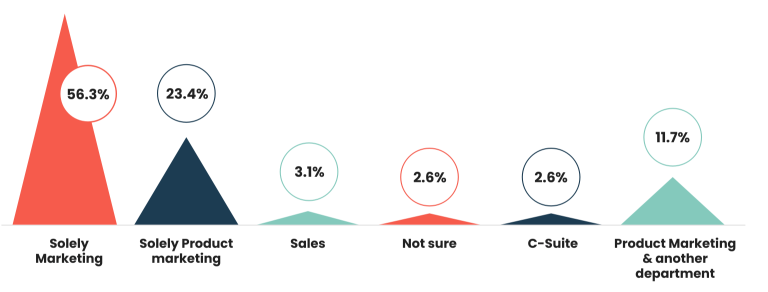Sales enablement is a big part of most product marketers’ day-to-day, and we know this to be fact thanks to the 2,000+ product marketers that participated in the 2020 State of Product Marketing Report. Almost three-quarters of the PMMs surveyed (73.8% to be exact) said that creating sales collateral was one of their key responsibilities.
With that number in mind, we decided to delve a little deeper into the data to see how product marketers take ownership of sales enablement and structure their teams in over 400 B2B and B2C companies.
We asked PMMs…
And to kick off the survey, ‘do you have a dedicated sales enablement team?’

As you can see, results were almost split here, with 47.9% answering no, and 43.6% answering yes.
Curious as to why 47.9% of PMMs don’t have a dedicated sales team, we wanted to find out if ownership was behind the almost even split.
Who owns sales enablement?
Just over half of the 400+ respondents said sales enablement was solely owned by marketing.
It’s worth noting that sales (and marketing) are usually cited as owning sales enablement in most cases so it was surprising to see that in this demographic only 3.1% answered sales.

However, Igor Kranjec, Product Marketing Lead at Lemax, didn’t find this unusual in the slightest.
“In my experience, sales enablement is traditionally owned by the marketing teams so the numbers didn't surprise me. But, I think this should, and will change in the following years. Ownership should swing more towards product marketing. PMMs are in a perfect position between products, marketing, sales, and the customer, which gives them not only a good overview of the entire landscape but they are in the rare position to have insight into the company and customer view of the product, problems it solves and the value it brings.”
Intrigued by the results and Igor’s quote we asked a few more Product Marketers how it works at their organizations and here’s what they said…
“My company is very small so we don't have a dedicated team to handle sales enablement. The PMM (me) handles it. I work closely with the sales reps on which content adds value to our customers, and build it into the relevant GTM plans. I also execute on the deliverables myself.” - Daniella Latham, Product Marketing Manager at Kahoot!
“Marketing works on sales enablement content as required by the sales team.” - Rohit Avinash Naidu, Product Marketing Manager, 42Gears Mobility Systems
“We're really early in our sales enablement journey but it's one of my team’s goals to mature it. Either the PMM or someone from marketing gets ad hoc requests from sales to generate collateral.
"For the most part, the sales team does their own deck/demo creation, etc. but it's one of the PMM team's goals to move from less of a reactionary approach to more of a strategic one where we solicit content needs from the sales team via a survey AND assess content needs and gaps at each stage of the sales funnel/buyer journey.
"This would be based on research from various companies and other resources and have PMMs work with product leads to training the sales team/provide the sales team with collateral proactively as part of launches.” - Anonymous Product Marketing Team Lead
It was interesting to find that the PMMs whose teams owned sales enablement at their organization expressed that “most of my role involves sales enablement", while the PMMs who answered "some of my roles involves sales enablement" also work at an organization where product marketing is responsible for sales enablement.
One-third of the 400+ respondents (34%) of PMMs with a dedicated sales enablement team answered that some of their roles involved sales enablement, while a surprising 32% answered that most of their roles still involve sales enablement.
Sales enablement team structures
With so many variables at play, it was impossible to pin down a common structure when it came to sales enablement teams, which is why we reached out to PMMs in various growth stage organizations for a first-hand account of how it works at their company.
Here’s what they had to say…
“The sales enablement team helps develop sales proposals and respond to RFPs. No other sales enablement materials are developed by the team. They report to the Sales Operations department.” - Tirrah Switzer, Senior Product Marketing Manager, Community Brands
“We have a dedicated Sales Development team, which consists of sales training and sales recruiting. Sales training handles all the collaterals, training methodology, etc. I head the training for a region.” - Fayaz Rahman, Business Development Manager, Byju's
“Sales enablement is part of our operations team and is geography-based.” - Rita Jackson, VP of Product Marketing, MuleSoft
“We have a Director of Sales Enablement that works with regional sales managers and directors of sales.” - Hila Lauterbach, Director of Product Marketing, SpotOn
“There’s a Global Head of Sales Enablement, with five supporting sales enablement managers. Two focus regionally (EMEA and US) on our account executives, one focuses on our BDR teams globally, one manages our sales enablement platform and then one person is more focused on operations.” - Igor Kranjcec, (People) Manager of Product Marketing, Lemax
“We have a Head of Sales Enablement in each of our three regions. Each region organizes as it sees fit. The central enablement team provides support and product marketing supports enablement efforts.'' - Peter Chargin, VP of Product Marketing, VMware
“Each sales manager has a dedicated strategist that supports building client-specific sales presentations, responding to RFPs with tailored proposals, completes RFIs, etc.” - Robert Lawrence, Senior Director of Product Marketing, AdTheorent
“Reporting to operations and a very close tie to marketing, sales enablement supports and is organized by leads across sales and customer success.” - Jonathan Hinz, Director of Product Marketing, Seismic
“We have four amazing folks in our sales enablement team who support our direct sales team.” - Div Manickam, former Director of Product Marketing, Dell Boomi
“We have a head of sales enablement and a sales enablement manager that ladders up to him.” - Jessica Materna, Senior Product Marketing Manager, Litmus
As you can see, when it comes to sales enablement team structures, there’s no one size fits all solution and we have no doubt that the statistics we unearthed here will continue to shift and surprise as product marketers take on more of an active role in sales enablement.
Would you like to learn more about sales enablement? Check out our Product Marketing Core [On Demand] course and get certified! If live and online is more your speed, you can get certified on our live interactive course, delivered in person by a product marketing expert.


















 Follow us on LinkedIn
Follow us on LinkedIn



.svg?v=63a50ae3ef)